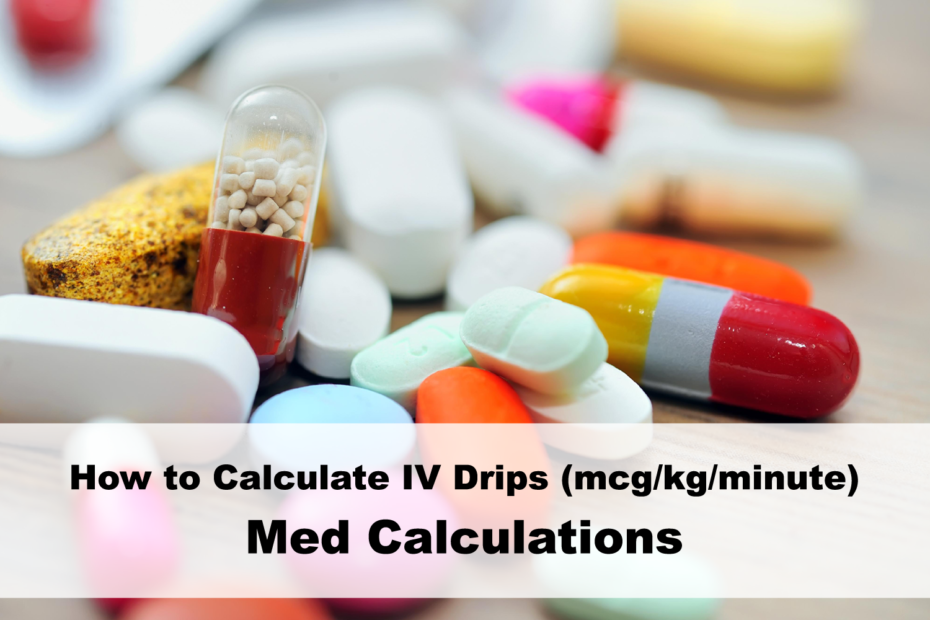Welcome back to our med calculation series. We’ve reviewed quite a bit of information so far including the Universal Formula and Dimensional Analysis (DA). We used the Dimensional Analysis method to calculate tablet doses, intravenous bolus doses and continuous IV drip rates in units per hours (unit/hr) and micrograms per minute (mcg/minute). We will now take the DA method one step further to calculate weight-based continuous IV drips (mcg/kg/min to mL/hr & mL/hr to mcg/kg/min)
After reading this blog you are able to calculate IV Dose/kg/hour:
- mcg/kg/hr into ml/hr
- unit//kg/hr into ml/hr
- mg//kg/hr into ml/hr
- ml/hr into mcg/kg/hr
- ml/hr into unit//kg/hr
- ml/hr into mg//kg/hr
IV Drips: How to Convert in mcg/kg/min to mL/hr
Example: Administer dopamine at 10 mcg/kg/min. The pharmacy provides dopamine 800 mg in 250 mL of D5W. What is the hourly IV pump rate? The patient weighs 85 kilograms.
Step 1: What label is needed? We want to know what rate to set the IV pump.

Step 2: Place the same label in numerator.

Step 3: Alternate labels in numerator and denominator so labels cancel out.
We want to get to micrograms and we know 1 milligram (mg) equals 1000 micrograms (mcg). Place this in the equation so that milligram labels will cancel out.

Add the prescribed dose 10 mcg/kg/min, placing mcg in the numerator so that it will cancel out.

Add 60 minutes/hour next so that minutes cancel out.

Finally, add the patient’s weight in kilograms. If the weight is in pounds, you will need to convert it to kilograms before adding it to the equation.

Cancel out the labels until you are left with mL/hour.

Step 4: Multiply numerators, multiply denominators, then divide numerator by denominator.

Answer: 16 mL/hour
IV Drips: How to Convert mL/hour to mcg/kg/min
Now let’s reverse the calculation.
Example: You are waiting to receive shift report. In the meantime, you review the continuous drips that are running. You see your patient is on a dopamine drip and the pump rate is 16 mL/hour. The concentration of dopamine is 800 mg/250 mL. The patient weighs 85 kilograms. What dose is your patient receiving?
Step 1: What label is needed? Since we are looking for the dose in micrograms per kilogram per minute (mcg/kg/min) and it is difficult to solve with more than two variables, let’s first solve for mcg/min. Then we will incorporate the weight (kg) at the end.

Step 2: Place the same label in numerator. Before we can do this, we need to convert the concentration from miligrams (mg) to micrograms (mcg). Our concentration is 800 mg in 250 mL. Multiply this by 1000 mcg per mL and simplify the fraction to get 3,200 mcg/mL.

This can now be added to the right side of the equation.

Step 3: Alternate labels in numerator and denominator so labels cancel out. We know our current pump rate is 16 mL/hour. This is placed next in the equation.

We know there are 60 minutes in one hour. This is placed next in the equation.

Cancel out the labels until you are left with mcg/min.

Step 4: Multiply numerators, multiply denominators, then divide numerator by denominator.

Step 5: Divide by the weight in kilograms to get mcg/kg/min.

Answer: 10 mL/hr
Click Here for Continuous IV Drips Calculator which allows you to calculate:
- mcg/kg/min to ml/hr calculator
- unit//kg/min to ml/hr calculator
- mg//kg/min to ml/hr calculator
- mcg/kg/hr to ml/hr calculator
- unit//kg/hr to ml/hr calculator
- mg//kg/hr to ml/hr calculator
General Tips:
- Check that your answer makes sense clinically.
- Double check your work.
- Have a colleague or pharmacist check your work.
- Know general therapeutic drug doses for commonly administered medications.
These calculations can be tricky but get easier with practice. In the next and final installment of this series, we will review how to calculate drops per minute which is a handy calculation to know when you are not using an IV pump. Be sure to check back next month!
References:
Cookson, K.L. (2013). Dimensional analysis: Calculate dosages the easy way. Nursing2013, 43(6), 57-62.
Koharchik, L.S. & Hardy, E.C. (2013). As easy as 1, 2, 3! Dosage calculations. Nursing Made Incredibly Easy!, 11(1), 25 – 29.
Wilson, K.M. (2013). The nurse’s quick guide to I.V. drug calculations. Nursing Made Incredibly Easy! 11(2), 1 – 2.
